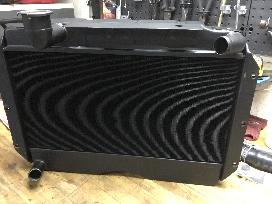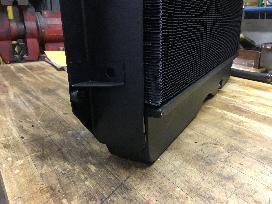The MGA With An Attitude
CANTILEVERED THICKER RADIATOR - CO-305
from The Brassworks
On September 29, 2018, Rob Zucca wrote:
 I have recently had a custom radiator built. I’ve never had any cooling issues, and the old re-core that came with the car seemed to work just fine. My radiator began to leak along the top tank to core solder joint on the engine side, and my local guy was timid about trying to solder it up, was afraid he’d open the seam and then have to remove the top tank to fix it. At that point a re core would make sense. He had no access to cell cores and I contacted The Brassworks to inquire about a re-core. They’re completely capable of doing cell cores and more, but I decided to try something different. I have recently had a custom radiator built. I’ve never had any cooling issues, and the old re-core that came with the car seemed to work just fine. My radiator began to leak along the top tank to core solder joint on the engine side, and my local guy was timid about trying to solder it up, was afraid he’d open the seam and then have to remove the top tank to fix it. At that point a re core would make sense. He had no access to cell cores and I contacted The Brassworks to inquire about a re-core. They’re completely capable of doing cell cores and more, but I decided to try something different.
 What we decided was to build a new lower tank, use the original top tank and re core with a new tube and fin core built by Brassworks. The original cores were two inches thick. We went with 2-5/8 thick. To do this the new bottom tank is built with a cantilever over the air pan. The original top tank was wide enough to accommodate the thicker core. This did shorten the size of the core. The width remained the same. The stock opening is 18-3/4 x 11-1/8 which is 208 square inches and at 2 in thick, 417.18 cubic in of core. The new core is 18-3/4 x 9-5/8 which is 180.46 square inches and at 2-5/8 thick, 473.73 cubic in of core. What we decided was to build a new lower tank, use the original top tank and re core with a new tube and fin core built by Brassworks. The original cores were two inches thick. We went with 2-5/8 thick. To do this the new bottom tank is built with a cantilever over the air pan. The original top tank was wide enough to accommodate the thicker core. This did shorten the size of the core. The width remained the same. The stock opening is 18-3/4 x 11-1/8 which is 208 square inches and at 2 in thick, 417.18 cubic in of core. The new core is 18-3/4 x 9-5/8 which is 180.46 square inches and at 2-5/8 thick, 473.73 cubic in of core.
 It took 12 weeks. Brassworks is busy. I installed it and it’s working great. I’ll need to wait until next summer to really check it as we’re down to the low eighties now. On my standard twenty mile loop here which includes highway, twisties and “ the Norwegian grade” I’ve been able to compare all three radiators with the same 80 degree ambient temperature. The new radiator is superior to the old re-core by far. How much better? Time will tell. There’s no comparison with the toy repro radiator. What a waste of copper. I’m very tempted to buy an old original radiator, have it re cored with a cell core and complete the comparison. It took 12 weeks. Brassworks is busy. I installed it and it’s working great. I’ll need to wait until next summer to really check it as we’re down to the low eighties now. On my standard twenty mile loop here which includes highway, twisties and “ the Norwegian grade” I’ve been able to compare all three radiators with the same 80 degree ambient temperature. The new radiator is superior to the old re-core by far. How much better? Time will tell. There’s no comparison with the toy repro radiator. What a waste of copper. I’m very tempted to buy an old original radiator, have it re cored with a cell core and complete the comparison.
 Below find some images of the new radiator and an e mail from Lee at the Brassworks responding to my question of specifications for the core. The radiator cost about a grand with most of the labor being in hand fabricating the lower tank. I would recommend them highly. Beautiful work by people who enjoy what they do and are excellent craftsmen. -- Rob Zucca Below find some images of the new radiator and an e mail from Lee at the Brassworks responding to my question of specifications for the core. The radiator cost about a grand with most of the labor being in hand fabricating the lower tank. I would recommend them highly. Beautiful work by people who enjoy what they do and are excellent craftsmen. -- Rob Zucca


From: Lee Chamberlain - lee@thebrassworks.net
Date: September 25, 2018
To: rob zucca
Subject: Re: MG radiator
 The cores we construct in house here at The Brassworks. The cores we construct in house here at The Brassworks.
 Tubes are made to our specification in Canada. Tubes have an .007" wall and a seamless-laser weld joint. The tubes are a 3/4" in length and formed in an elongated ellipse shape. Tubes are arranged as a stagger array to tumble and disrupt the airflow over the fin laterally. Tubes are made to our specification in Canada. Tubes have an .007" wall and a seamless-laser weld joint. The tubes are a 3/4" in length and formed in an elongated ellipse shape. Tubes are arranged as a stagger array to tumble and disrupt the airflow over the fin laterally.
 The fins are made of tellurium copper and are .00297" thick. We used to have to bring our copper in from Sweden but the company acquired a US facility and reduced our lead time, transport costs and saved some jobs here at home. We like that. The fins are made of tellurium copper and are .00297" thick. We used to have to bring our copper in from Sweden but the company acquired a US facility and reduced our lead time, transport costs and saved some jobs here at home. We like that.
 To squeeze more cooling capacity out of a heat exchanger a core can be made denser or deeper. There are limits and trades offs to both; too dense you create and air damn that blocks air passage, too deep you risk heat soaking the air as it passes. On your core we opted for a fin density of 10 fins per vertical inch and a depth if 2-5/8". To squeeze more cooling capacity out of a heat exchanger a core can be made denser or deeper. There are limits and trades offs to both; too dense you create and air damn that blocks air passage, too deep you risk heat soaking the air as it passes. On your core we opted for a fin density of 10 fins per vertical inch and a depth if 2-5/8".
 We sometimes use a cantilever tank design when we meet obstacles like air deflection panels and we can even cantilever a whole radiators when there is no hood or a stretched hood. We 're able to retain the original mounts and gain room for fans by extending the mounts. We sometimes use a cantilever tank design when we meet obstacles like air deflection panels and we can even cantilever a whole radiators when there is no hood or a stretched hood. We 're able to retain the original mounts and gain room for fans by extending the mounts.
 Most of the time these are bespoke solutions for unique problems. What's nice about this is we can convert the MGAs over to this larger core (or an even larger core) without tooling up. Most of the time these are bespoke solutions for unique problems. What's nice about this is we can convert the MGAs over to this larger core (or an even larger core) without tooling up.
Regards,
Lee
The Brassworks
500 Linne Road - Unit I
Paso Robles, CA 93446
Tel: 805.239.2501
|